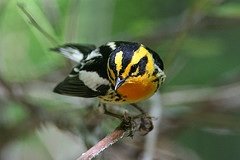Birds, Birds, Bicknell and Blackburnian
Mid-May I woke up and heard bird songs. Of course I had always heard birds rattling away in the morning, a blur of noise that told me the world was alive. Suddenly, though, as if a part of my hearing had suddenly clicked into place, there emerged distinct calls in rhythm and volume, in pitch and repetition. That’s all I heard. When in the past I could walk without really seeing or hearing anything, now I can’t walk without hearing every peep, chirp, chip, slur. And wondering who it is.
I’m not the first to suddenly be taken with birds and their songs. But I feel lucky to join a large and often nerdy bunch of people wandering the globe with a range of binoculars, scopes and cameras and a will to see. If only for a moment. There’s one thing I’ve learned: birding is about moments, flashes. You don’t hold onto these birds. You are lucky to get a glimpse.
Across the Hudson River Mark DeDea at the Forsythe Nature Center organizes nature walks that often focus on birds with the John Burroughs Society. For the past two weekends I’ve joined them on walks/hikes led by Christine Guarino, an energetic young woman who is part parrot and who hears everything.
The first walk I joined was at the Lundy Estate, a 5,200 acre property, currently held by the Department of Environmental Conservation. It’s a gorgeous piece of land—fields and forests merge together, with the remnants of a plan: a row of tall white pines, forming an allee. It lies south of the Catskills, and north of Minnewaska State Park, offering a bridge between these two swatches of protected areas. From the web, I’ve gathered some of this land’s complicated history (if someone out there actually reads this and knows more, do let me know). Frederick Lundy, the most recent owner, was a restaurant owner in Manhattan. He bought the original land in the 1920s and added to it during the Depression. From the web (reliable source? Who knows): “After a 1926 kidnapping, numerous armed robberies, a shoot-out at the restaurant, and finally, the suspicious death of his sister and her husband, Lundy became a recluse. He lived above the cavernous restaurant with 14 Irish setters and a servant. An elaborate scheme to defraud him of $11 million kept his name in the headlines for years after his death.”
Not sure who was kidnapped, but the 14 Irish setters overwhelm and delight me.
For this walk, 21 people showed up. Peter Schoenberger stood out for his three foot long, ten pound (or more?) camera. The Blackburnian at the top of this post is his; other photos, posted on flickr, are marvelous. We spent a long time trying to coax in a Blackburnian warbler, with no luck. So let me be honest: until that Saturday I had never even heard of a Blackburnian warbler. But after that day I wanted to see one.
Yesterday, June 6, I woke at 4 in the morning (awake before the birds) and drove across the river to Slide Mountain, the highest peak in the Catskills and one of my favorite hikes, with this same group. We were a smaller group—only six—and our goal was to see the Bicknell Thrush, which was first identified as a species distinct from the Gray-Cheeked Thrush, on Slide Mountain.
Minutes out of the car Christine was pointing left, then right: Ovenbird, Redstart, Black-throated Blue. To watch someone with such an ear in action is thrilling and she, as well as Mark, are generous with what they know and willing to field the simplest of questions. Thrushes live at different altitudes—the Wood Thrushes down low, the Swainson and Hermit mid mountain, the Bicknell near the top. We headed up.
Near the summit, the mountain shrouded in fog, the birds were just getting started on their morning’s business of eating or finding mates. And yes, there was the song of the Bicknell Thrush, which to my ear, like all thrushes, is a bit haunting, a hollow noise in the middle that lacks the cheer of many bird songs. (Listen here). So we “pished” and stared into the dense fir forest and hoped, and had moments of excitement (but that was only a Blackpoll warbler…or some other bird teasing us with its movement), and hurt our necks and, for me became momentarily discouraged, then excited, then frustrated. You have to be emotionally flexible to bird. No Bicknell.
I did not feel disappointment, but rather a sure determination to return.
On the descent, long after my mind was soft with bird sounds and trying to remember what was that still singing at such a late hour (now past noon) there he was, the Blackburnian I did not hope to see, perched in a tree just above me. Bear with me here—is this not true to life? After we stop looking, there’s the Blackburnian.
